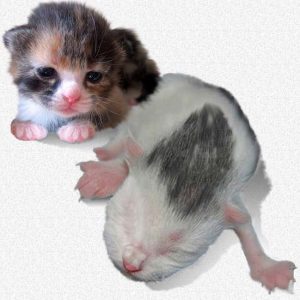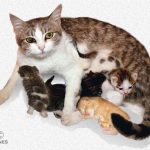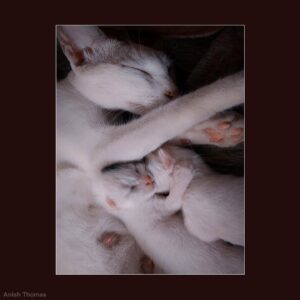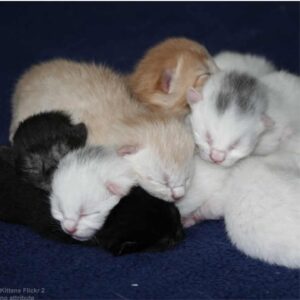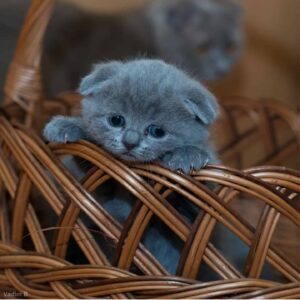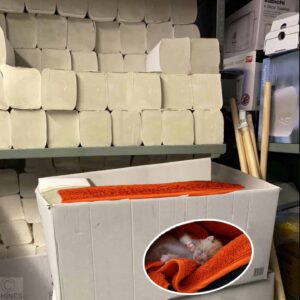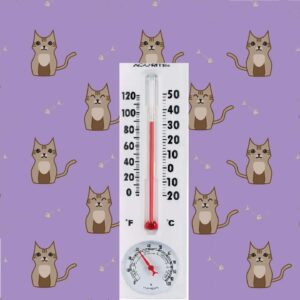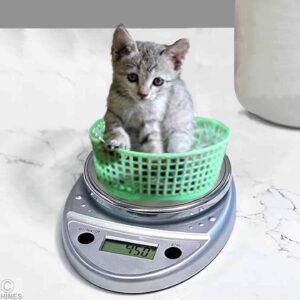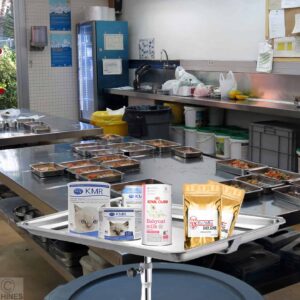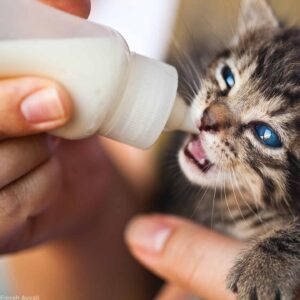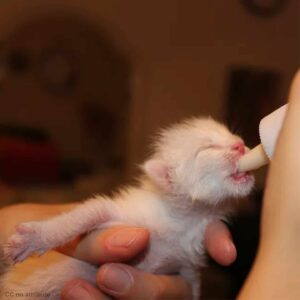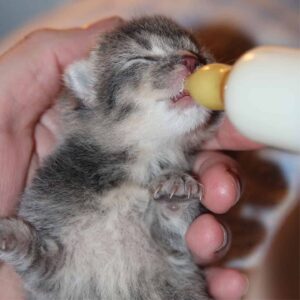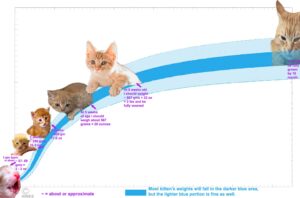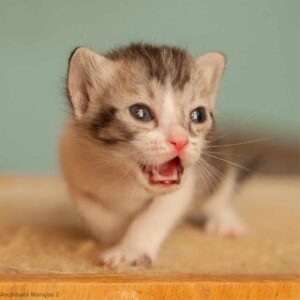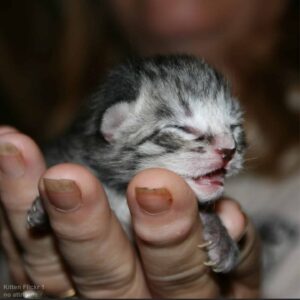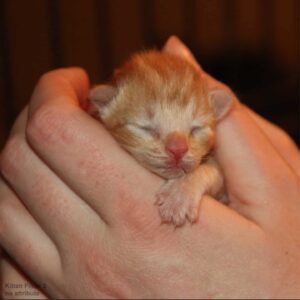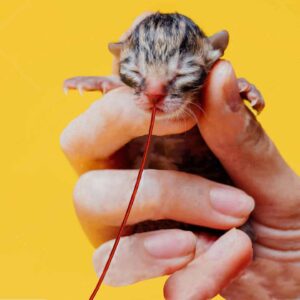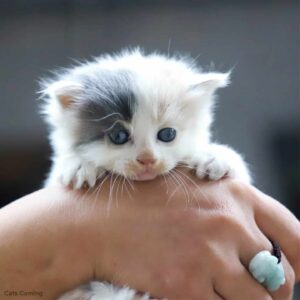A newborn  kitten like me will look as mature as my calico cousin in about two weeks
kitten like me will look as mature as my calico cousin in about two weeks
Bottle – Feeding Orphaned Kittens
Ron Hines DVM PhD
Motherly love is intense in domestic cats. So it is quite rare for a well-kept, healthy momma cat to abandon her babies. But feral, homeless cats lead very different, stressful lives. They struggle on the borderline of starvation, live in unnaturally dense groups and suffer from diseases, parasites and peer pressure that pampered house cats never face. It is not much better for unneutered yard cats. Their first litter arrives when they are little more than kittens themselves. It is quite common for inexperience and the stresses of pregnancy to exhaust them to the point where they abandon their kittens, or lose them to malnutrition, parasites and other hazards. The kittens that fight hardest to survive, out compete and outgrow their littermates. The one(s) that drop behind rarely survive without your intervention. Those are all circumstances that might have brought you to this page.
How Old Do You Think This Kitten Is?
Kittens 1–14 days old haven’t opened their eyes yet. (never attempt to open a kitten’s eyes manually) Their ears are also folded over and closed. Kittens 2–3 weeks old have opened their eyes. They are able to move around, shakily. By the time kittens are 3 weeks old, their ears have become erect, and they can walk about confidently.
What Supplies Will I Need?
A Nest box
Mother cats instinctively seek out quiet, small, confined, low traffic areas in which to place their kittens. If not quite right, they carry their kits around in search of a better location. Occasionally, one will get left behind, or lost somewhere along the journey. Consider yourself their mother now. Your nestbox doesn’t need to be elaborate. It needs to be big enough for your kitten(s) to turn around in, but not too much bigger. I couldn’t resist placing the photo of the Russian blue kitten in the wicker basket above because it was so cute. But wood and wicker are impossible to sanitize adequately. Wicker’s open weave, it and fenestrated laundry baskets afford many opportunities for kittens to get their head stuck – or worse. I prefer a simple cardboard box similar to the one in the imaginary photo above. When it becomes soiled, just replace it with a new carton. Pantry and bathroom closets like the one in my imaginary photo need to be free of volatile, toxic cleaning products such as bleach, ammonia, drain cleaners, roach or mouse bait, active washers, and driers, etc. You can line the container with unneeded towels or portions of soft, family clothes that your family no longer needs. Be sure to remove buttons, zippers and any hanging threads that could lead to entanglements.
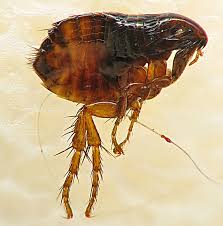
No Fleas
Before you place the kittens in the box, examine them closely for fleas. I pick fleas off with eyebrow tweezers and drop them into a cup of rubbing alcohol or vodka. In a confined space, those little pests can quickly suck kittens dry of blood. If there were many fleas and the kittens gums are pale (anemic), a drop of pediatric vitamins with iron per day might be helpful. (read here) Place the box in a draft free location. Be sure the sides of the box for young kittens are at least six inches tall, so they cannot fall or climb out. As time goes by, your box will need to be taller. Make sure that the area is protected from your other pets and children. Children are fascinated with kittens. They can easily over love them. Another concern is that these kittens can be a source of ringworm fungus that spreads to children very easily. (Your veterinarian can screen them for ringworm with a black light.)
A Thermometer And A Heat Source
Purchase a thermometer. Supplemental warmth is especially important during your kitten’s first 14 days of life. That is because it has not yet developed the ability to control its body temperature (thermoregulate). Snuggling against its mother, the kitten(s) had a comfortable ~88-95°F/31-35°C environment. Their mom’s internal temp is higher, 101-102.5°F/38.-39°C). During those first two weeks of life, kittens cannot shiver to generate the heat they need when they are cold. When their body temperature is too low, they cannot digest the milk you plan to feed it. Without their mother to warm them, they will rely on your heating pad or a hot water bottle for warmth. Keep the pad under only one side of the box and set it only on its lowest setting. Wrap the pad with sufficient cloth towels so that the inside of the box does not rise above 90°F/32°C. After the/they are two weeks old, with only one side of the box heated, your kitten(s) will hopefully be able to crawl away from the heat source if it becomes too warm for them. This is very important because more rescued kittens die from overheating than from being chilled. As I mentioned, if your kitten is not slightly warm to your touch, it will not be able to properly digest the milk you feed it. As the kitten matures, gradually lower the temperature in the box. A towel placed over the nestbox for the first few weeks helps keep temperatures stable. When your kitten reaches the end of its first month of life, it should be fine at room temperature (68-86°F/20-30°C). Avoid placing the nestbox near air vents or in drafty areas. Even from 4 to 6 weeks, it is wise to continue having a heat source that the kittens can move closer to, or farther away from, as they desire. At that stage of their life, kittens in groups are less dependent on outside heat sources than those dwelling alone. Check your thermometer frequently. Place your hand against the thermometer when it is at 100°F/38°C, then against the kitten’s tummy. They should feel about the same. Snuggle Safe and similar microwavable heating pads are said to accomplish the same thing as electric heating pads and hot water bottles. But I have no experience using them. Heat lamps are never a good idea. They cause thermometers to give inaccurate readings. When thermometers are in their light beam, they read too high. When they are not, they read too low.
A Scale And A Notebook
Just like us, every kitten is a bit different in the amount of milk it prefers to receive in a single meal, and its preferred total daily milk consumption. Consequently, they will grow at slightly different rates. The important thing is their pattern of weight gain. There should be a steady, smooth increase in your kittens weight from day to day, with no flat lines or downward trends that you cannot account for. Things happen. You get preoccupied with other matters and feed less often. There might be more than one kitten caretaker involved. When you weigh your kitten(s), try to be consistent. Weigh them at the same time of day (before or after feeding) before or after stimulating them to pee. Try to be consistent.
Milk
For as long as I have been in practice, the most popular brand in the United States has been KMR® (Kitten Milk Replacement). It is still them most popular brand here. KMR® is a product of PetAg. Their puppy formula is Esbilac®. Both were originally developed by Borden, Inc. Around since the 1800s, they had a lot of dairy residues they needed to find a market for. When Borden divested itself of its infant pet and livestock milk replacement brands, some of their employees with the knowledge as to how they were produced opened up their own company. I believe that that was the start of the Fox Valley line of animal milk replacements. More recently, the Mars Conglomerate saw opportunities in the same area. Their kitten milk product, Baby Cat Milk®, is sold under their Royal Canin label.
I cannot tell you which brand of kitten milk replacement will be best for your kitten. Of the three, KMR® is the least expensive and most widely available and Fox Valley is, I believe, the most expensive. Baby Cat Milk is sold on Amazon, but so far, it has penetrated the UK and European markets more than it has in the United States. Only Baby Cat Milk® provides it DHA level and uses that addition as a marketing tool.
I use KMR. I use the powdered product, not the canned product, because I have large numbers of immature animals to feed. Powdered KMR needs to stand for a while after preparation to fully dissolve. Baby Cat advertises that their product dissolves instantly. Baby Cat has added fish oil as a source of DHA. The other two products do not advertise that they contain added DHA. However, no one knows the optimal amount of DHA required by kittens. A bit more is known about the requirements of puppies. (read here)
 Powdered KMR advertises their product as a complete diet for kittens up to 6 weeks of age and as a supplement thereafter. They do not list its DHA content. AAFCO https://en.wikipedia.org/wiki/Association_of_American_Feed_Control_Officials requires 0.012% EPA and DHA in all food marketed for cats. However, the KMR label does not list its DHA or EPA content and contains no fish oil, the most common ingredient added to increase DHA content. It is 42% protein and 25% fat. Ash and carbohydrate content is not given.
Powdered KMR advertises their product as a complete diet for kittens up to 6 weeks of age and as a supplement thereafter. They do not list its DHA content. AAFCO https://en.wikipedia.org/wiki/Association_of_American_Feed_Control_Officials requires 0.012% EPA and DHA in all food marketed for cats. However, the KMR label does not list its DHA or EPA content and contains no fish oil, the most common ingredient added to increase DHA content. It is 42% protein and 25% fat. Ash and carbohydrate content is not given.
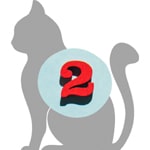 Powdered Baby Cat: Analytical constituents: 33% protein, 39% fat, 6% crude ash and 0.5% fish oil (the source of DHA). It contains no starch carbohydrates. But it does not list its non-starch carbohydrates. They advertise that DHA is essential for proper nervous system development. That is true. But we know that many animals can synthesize DHA from the fatty acids (eg alpha-linoleic acid) that all three products are rich in. (read here) If kittens can manufacture their own DHA in sufficient amounts as adult animals do is unknown.
Powdered Baby Cat: Analytical constituents: 33% protein, 39% fat, 6% crude ash and 0.5% fish oil (the source of DHA). It contains no starch carbohydrates. But it does not list its non-starch carbohydrates. They advertise that DHA is essential for proper nervous system development. That is true. But we know that many animals can synthesize DHA from the fatty acids (eg alpha-linoleic acid) that all three products are rich in. (read here) If kittens can manufacture their own DHA in sufficient amounts as adult animals do is unknown.
 Powdered Fox Valley 0.17 Kitten Formula is 40% protein and 25% crude fat. Carbohydrate content is not given. It advertises that extra taurine has been added. It is said to be a complete diet until kittens are 3–4 weeks old, after which kitten food should be added and the kittens fully weaned by 6-8 weeks. It advertises that it only contains human-grade ingredients, but does not mention its DHA content and fish oil is not listed as an ingredient.
Powdered Fox Valley 0.17 Kitten Formula is 40% protein and 25% crude fat. Carbohydrate content is not given. It advertises that extra taurine has been added. It is said to be a complete diet until kittens are 3–4 weeks old, after which kitten food should be added and the kittens fully weaned by 6-8 weeks. It advertises that it only contains human-grade ingredients, but does not mention its DHA content and fish oil is not listed as an ingredient.
Many feel that powdered kitten milk replacements have short shelf lives – particularly after the container’s seal has been broken. they are all more economical than pre-diluted milk replacements. Some, like KMR need to stand for several hours in order to be entirely free of lumps and assume a smooth consistency. They must all contain considerable unsaturated fats to meet your kitten’s needs. And unsaturated fats have a tendency to form unhealthy peroxides when exposed to air, light or high temperature. To retard spoilage, all three products contain a liberal amount of alpha-tocopherol (vitamin E). That is why I always store them in my refrigerator and buy them from stores that have the most rapid turnover. The canned products are less economical over time, but they come ready to warm and serve. Also, rancidity is unlikely to occur in these pre-diluted canned products because the water already added slows the oxidation of fats.
I do not have any ties to Pet-Ag. It’s just that their products are usually the easiest to find. The Fox Valley line is just as good – some say better. I have no experience using Royal Canin Baby Cat™.
Feed all of these formulas at about 38C/100F. Using any of them, the average kitten will drink about 30 ml(1 oz or 2 Tablespoons) for each 113 grams of its body weight during a full-day cycle. The best judge that your kitten is doing well on your milk replacement amount and timing is that it is steadily gaining weight. There are often some initial bumps in the road because you are unlikely to feed the kitten as frequently and in as small amounts as its mother did. You probably won’t have the ability to feed more than every two hours or so. Very small, but frequent feedings are more crucial when hand raising litter runts, early age arrivals and kittens with various health issues. I do not place formulas in the microwave to warm them. I place water in a ceramic bowl in our microwave, heat that, test its temp with my finger, add cooler tap water as needed, and then let the reconstituted formula in its feeding bottle or syringe sit in that until it is warm enough to feed. Which ever way you are feeding, try to avoid bubbles in the formula. If you see them, let the liquid stand for a while.
Bottle Feeding
The position of your kitten, while you are feeding it is important. Never feed it with its back down (floor side) and its tummy up. Doing so, increases the likelihood that milk might go down wrong. The bottle or syringe is best maintained at a 45-degree angle. They are likely to squirm and struggle less when wrapped in a face towel. Little claws grasping the towel seem to calm kittens. You might have to use your finger nail to gently open its mouth at first until the taste of the milk instinctively prompts it to suck and swallow. Air bubbles rising in the bottle means that milk is coming out the nipple end (that is not the case with syringes). Its tiny ears often wiggle as well when a kitten is successfully nursing. I use 1 ml syringes with no needles for tiny kittens. When using any syringe without a catheter to feed, administer from the side of the jaw, not straight on as you see in the photo above.
It is human maternal nature to overfeed rather than underfeed kittens. That’s just the way we are wired. Weight gain is not a race to the top. It is always safer to slightly under feed than to overfeed – particularly with too many large feedings which greatly increase the chance of aspiration pneumonia and colic. Since I always have KMR powder in my refrigerator, I mix my milk formulas first thing in the morning that I intend to use them. I believe that powdered formulas do not keep fresh nearly as long as advertised. A good kitten-nursing bottle holds 2–4 ounces of formula. They generally come without holes punched in the nipple. I use a flame-heated 20 gauge needle to melt two small holes in the cap. These holes need only be big enough so that a few drops of milk drip out when the bottle is pointed downward and vigorously shaken. If too many holes are punched in the rubber cap, kittens can inhale the formula rather than swallow it. If you are using a canned pre-diluted product, still dilute the first few feeding 50-50 with Pedialyte™. If you are using the powder, mix it half-strength with boiled water or Pedialyte for the first few feeding and then gradually, over the next 24–36 hours, bring it up to full strength. Mix it really well, so that all the lumps dissolve. Let the formula cool until it is slightly above room temperature. As I mentioned before, always feed your kitten(s) while they are resting in your palm on their stomachs. Never feed them upright or on their backs as you would your human infant. You can wet the outside of the nipple with milk formula to give it flavor. Then, gently insert the nipple into your kitten’s mouth using a prying motion while you apply slight pressure to the sides of the bottle to release a drop or two of milk. From then on, your kitten should suck on its own. I am sure you will find plenty of how to videos about that on YouTube as well.
If milk bubbles out of your kittens nose, milk is flowing too rapidly from the bottle, the kitten’s stomach is still full from its last feeding, you are holding the kitten wrong, or it is too weak to suckle normally. On extremely rare occasions, you are dealing with a kitten with a cleft palate, in which case tube feeding is your only option. But much more often it is due to too large a hole(s) in the nipple or over feeding. I microwave a bowl of water and set the bottle in it to heat the formula to 99–100 degrees Fahrenheit before use. Be sure to always check the formula’s temperature by shaking a drop or two onto your wrist. Never put the bottle directly in the microwave to heat. Some owners find it easier to feed newborn kittens from a one or three milliliter syringe and switch to a bottle when the kitten is two weeks old. (of course, the needle needs to be removed first)
Some experienced kitten rearers add a bit of plain yogurt or Bene-Bac™ by Pet-Ag to their milk formula. I do not. But if you do, add it after the formula cools. I only find products like those desirable when a litter of kittens is star crossed or stunted or when the conditions where they were kept were unsanitary. It is probably a very good idea to initially add these products to formulas fed to kittens that never nursed their mothers. After their first day or two of nursing on their mother, they are already seeded with their mother’s intestinal bacteria. Another reason to consider these products is when the kitten received antibiotics. Others add lactase enzyme (Lactaid™) when diarrhea becomes a problem; however, there should not be enough lactose in any of these three commercial milk replacements for lactose to be the underlying cause for the diarrhea. More likely, it was caused by your feeding schedule, the amount fed and or a kittens low body temperature.
Boil your nursing bottles and syringes at the end of every day. Between uses, keep them in the fridge. Kittens that did not nurse on the mother for their first 48 hours did not receive their first milk or colostrum. That makes them more susceptible to various infections, including those that cause diarrhea. After that short time window, they cannot absorb colostrum through their intestines even if you give it to them. Besides, cow-derived colostrum has different antibodies in it than cat colostrum. Because colostrum deprived kittens are more susceptible to infections, wash your hands well and beware of sour, contaminated formula. That is why it is almost always safer to leave kittens with their mother for at least their first 2 days. There is some thought that although bovine colostrum, given after day two, does not provide body-wide protection, it might provide local protection withing the intestinal tract. Others disagree and point out that the acidity of stomach acids destroys colostrum before it reaches the intestine. Perhaps kitten stomachs are less acidic. We do not know.
How Much Should I Feed As My Kitten Grows?
Birth weights of kittens range from about 57 to 89 grams. Their weight should double in their first one and a half to two weeks. However, birth weight is partially dependent on litter size, as is the rate of the litters weight increase after birth. Another important factor is the mother cat’s general health. Seek your veterinarian’s advice if birth weight does not double in 8–12 days and any time the kittens growth curve becomes flat.
The best way to judge if your kitten(s) are receiving the right amount of milk is to frequently weigh them. During their first week of life, they need about 15-60 ml of formula per day in multiple 2-8 ml feedings, increasing the amount as the first week goes by. Most feed about 6–8 times a day. During their second week of life, they need about 70-85 ml of formula in multiple 10-12 ml feedings. You can cut back to 6 feedings as the week goes by. One of the common problems in cutting back the number of feedings and increasing the amount of each feeding is diarrhea and colic. Should that occur, go back to the schedule you were using before the problem began. Also, remember that the kittens stomach can only expand so much. Feeding more than the kitten’ stomach capacity will cause vomiting, or worse, aspiration pneumonia. During their third week, kittens need about 90-112 ml of milk formula a day as that week goes by. You can probably reduce the number of feedings that week to 5. During their fourth week, healthy kittens consume about 120-145 ml of formula per day. During their fourth week, you should be able to reduce feeding times to 4. Always check the kittens butt frequently to be sure that feces has not accumulated around or blocked its anus.
When you feed formulas to kittens, you are not providing it in the way mother cats do. You are providing larger volumes at a single time that the kitten would receive snuggled up against its mom. With time, the kitten’s stomach should expand to accommodate that fact. However, that takes time. And the larger stomach takes up more space in the kitten’s abdomen, making colic more common in hand-fed, rather than mother-fed kittens. Forcing a kitten that turns it head away from you when you attempt to feed it is often a sign that its stomach is still full from its last feeding. When in doubt if that is the case, look at its growth curve. If it is still on an upward trajectory, refusing formula is probably due to exceeding its stomach capacity. If the growth curve is flat, try smaller but more frequent feedings.
At the end of its first week, a healthy kitten should weigh about 140 grams, about 5 ounces. It should be spending about ninety percent of its time sleeping and rarely cry between feedings. It ear canals should open between about its fifth and eights days. Its eyelids should open between its eights and fourteenth day, beginning first next to its nose. Those eyes will first be deep blue. It will be 9–11 weeks before its final eye color develops. You can readily determine its sex by the shape and placement of the vulva or penis. The two pores are closer together in females. The male’s penile pore is round. The female’s vaginal slit is vertical.
Beginning in its second week, spend more time stroking and talking to the kitten to begin to socialize it. Children should never be involved in that activity. After its fourth week, you can see if the kitten will begin lapping its formula from a shallow dish, but continue to offer it the bottle. I use shallow disposable jar lids and dab a finger drop of milk on its nose. Try that before you try the bottle, not after. By this point, the kitten should be comfortable at normal room temperature. Five-week-old kittens will usually drink their milk and eat soupy food from a dish. Slowly, over a week or two, bring the soupy food up to adult cat consistency. At the time food begins to be offered, a dish of water needs to be offed as well. I am not a fan of a life on dry cat foods. I believe that they encourage kidney problems occurring in later life. I know that kibble is less expensive and less messy. But there is a later price to pay for that convenience. Start getting your kitten used to more natural diets early in its life. When kittens are reluctant to convert to a soupy diet, a topping of savory beef or chicken broth usually does the trick. I make that broth myself. I don’t rely on baby food. Feeding homemade diets that lack sufficient calcium, vitamin D3 and other essential nutrients is a recipe for health problems down the line – including rickets. When kittens are ~ five weeks old, they enjoy getting out of their nestbox and wandering around under supervision. They need that exercise to develop muscle strength and coordination. They also need daily socializing play time with humans. By that time, they probably weigh about 454 grams/1 pound. If it’s a boy kitten, its two testicles should be visible. Even if it is entirely eating on its own, its stomach is still small, and it will need the opportunity to nibble throughout the day. About the time it begins grooming itself without your assistance, think about purchasing a cat scratching post. That might occur at 8–9 weeks of age.
Burping Your Kitten
After each feeding, hold hold your kitten upright with its tummy against your shoulder or chest and gently pat or stroke it gently until it burps, releasing trapped air. It will look like a yawn. Nursing bottles that do not release enough milk lead to more air being trapped as kittens nurse. If your kitten should bloat or become colicky, you can attempt to add a few drops of infant anti colic drops (simethicone/simeticone) to its formula, experiment with a new nipple, a different feeding angle, and other feeding techniques. Or try a different brand of formula.
Helping Your Kitten Pee And Poop
Kittens need to be stimulated to urinate until they reach about the middle or end of their third week. You need to do that before and after every feeding. Kittens need to defecate at least twice a day. One cause of infrequent defecation is dehydration – generally due to too warm or too cold an environment. Normal kitten stools are yellowish brown with a jam-like consistency. Before and after every feeding, gently massage its anus and urinary orifice with a damp cotton ball or Kleenex™ moistened with warm water until it urinates and defecates. Be very gentle when you do this. Don’t worry if occasionally no urine or stool is produced.
Once kittens are pooping and urinating on their own, they need a small low-sided litterbox in their crate or cage. Shredded paper in the litter box is fine. A few smears of poop and urine that was deposited elsewhere in the crate, when moved to the new litter box, often gives your kitten the needed hint to move its toiletry activity to that new location. Should the kitten need a bath, Dawn™ dish detergent is considered safe for kittens when used in moderation and followed by a warm water rinse and towel drying. Keep all soapy products out of its eyes. When bathed, your kitten may panic. So carefully clip its toenails with human finger nail clippers. Just the very tips, please, before the bath.
Tube Feeding
If your kitten is too weak to nurse, or if it has a disability that prevents it from nursing, it may need to be tube feed. For everyone else, I discourage tube feeding. Production line tube feeding is never a desirable way to raise kittens. Sure, it’s fast. But without the prolonged human contact of bottle feeding, it can cause lifelong psychological damage. But if it is this kittens only option, purchase some 1 and 3 ml syringes online. You will also need some red rubber, 3.5 French and later 5 French pediatric urinary catheters. The 3.5 ones are more comfortable for newborns, but they are hard to locate. Don’t buy the ones made from silicone, and they do not slide in easily. Five french catheters are considerably easier to locate than the smaller 3.5 Fr ones. You will have to snip off the luer lock at the top of 3 ml syringes. I have never located 3 ml catheter tipped syringes. Only 5 ml ones. Be sure that the 1 ml syringes you purchase have slide off needles. In some, the needle is integral to the syringe. Since there is not a large enough market for gastric catheters for kittens and puppies, what you will receive will have been designed as a urinary catheter. That is why there are three holes at the small end. They are to keep clots and dibries in urine from plugging the catheter inlet. You can snip them off if you like and shorten the catheter to a more appropriate length, or you can measure from the tip of the kittens nose to it belly button or the point of its last rib and place an ink mark at that point to inform you when you have inserted the catheter to the proper depth. An experienced tech at your favorite cat shelter is usually quite willing to show you how to properly tube feed an infant kitten. Have her/him show you how to properly open the kitten’s mouth and guide your hand the first time you attempt it. Your favorite vet tech might be willing to do that too. You are unlikely to find two people who agree on how it should best be done. Second best is watching YouTube videos. But some of them I have seen are really bad. There is rarely a need to lubricate the red rubber tube, just dip it in the milk formula. If it doesn’t slide down the kitten’s esophagus easily, a little smear of canola oil usually does the trick. It is extremely rare for even a 3.5 Fr catheter to end up in your kitten’s windpipe (trachea). Kittens instinctively shut the epiglottis when objects other than air approach it. If the kitten begins to fuss and squirm, remove the catheter, wait a minute and try again. Empty the proper amount of milk formula very very slowly. Little kittens have not yet developed a vomiting reflex, so they should not retch due to the tube. You have plenty of time. One set up, be sure to purge the catheter of air before you begin.
Some Common Problems And Not So Common Problems That Might Arise
I already mentioned most of them. They often pertain to star crossed runts or the litters of distressed mothers. Kittens that have been abandoned are often chilled, dehydrated and hypoglycemic. The most common cause of dehydration and hypoglycemia in newborn kittens is a lack of access to milk for 24–48 hours. Dehydrated kittens are weak and inactive. Their skin does not spring back when pinched, but instead has a clay or dough-like consistency. You can deal with the hypothermia. But fluids to correct dehydration in tiny kittens are best administered subcutaneously by veterinarians. Perhaps, if you have experience giving subcutaneous fluids to your elderly cat whose kidneys are no longer functioning properly, you could do it as well. But needle gauge must match body size and volume give must match body size as well. Kittens with subnormal body temperature need SC fluid and warming simultaneously. My favorite fluid for this is sterile 5% dextrose in 0.2% sodium chloride, not ringer’s solution because these infants don’t lack sodium salt. That particular solution is marketed for human infants whose dehydration is not due to vomiting, diarrhea or blood loss. Giving Karo syrup to a cold, weak, dehydrated kitten is unlikely to help.
The normal rectal temperature for a newborn kitten is said to be 92-99 F /33.3-37.2 C. As I mentioned earlier, little kittens cannot regulate their body temperature like older kittens and adult cats can. By their second week rectal temperature should be about 97-100 F/36.1-37.8 C. By their fourth week normal rectal temperature is usually 100-102 F /37.8-38.9 C, the same as adult cats. The first thing to do is to warm subnormal temp kittens very slowly and carefully to ninety degrees. They should respond with more meowing and movement.
As I also mentioned earlier, watery yellowish or greenish stools are sometimes caused by feeding too much or too quickly. If they occur, try diluting the formula 50-50 with Pedialyte™ until the stools return to their normal consistency. I have never given kittens kaopectate, but I know that some people do. The sodium salicylate in it can be toxic to cats.
Overly hard stools that are clumped and cheese-like are sometimes due to feeding your formula too concentrated or beginning solid foods too early. When kittens strain to defecate and pass overly hard stools, dilute the formula, increase the frequency of your feeding frequency but with smaller amounts. Impacted (bound up) kittens usually also have a bloated abdomens. You can give them a few drops of cat hairball paste to help them evacuate the stool. I like to gently massage their tummies shortly after that. If they still remain bound up, they need to visit your veterinarian where they might need a warm water enema and a search for the cause of the problem. Never administer phosphate enemas – such as Fleet™, to a cat.
It is a good idea to worm your kitten with pyrantel pamoate when it is seven weeks of age (or earlier if your veterinarian suspects intestinal parasites). That medication is often available at discount and pet-related establishments without a prescription. It is the same medication used to rid human children of pinworms. At pet stores, it is labeled for dogs, but works equally well in cats when given according to the cat’s body weight for removing roundworms and hookworms. It will not cure coccidiosis, a common cause of diarrhea in weakened kittens and at group homes. The only treatments for coccidiosis are certain antibiotics prescribed by your veterinarian along with generous amounts of oral fluids. A soothing salve on the kitten’s inflamed rear ends will help make it feel better. When possible, these kittens all need your veterinarian’s care.
If the kitten(s) are kept isolated from other cats, I suggest that its first vaccination against feline herpesvirus, feline calicivirus and feline panleukopenia be given at 12 weeks of age with a booster at 16 weeks. If other unvaccinated cats come in contact with the kitten, the first vaccine can be administered as early as 7 weeks, but the second shot still needs to be at 16 weeks or older – a time when the kitten’s immune system will be mature enough to fully benefit from the injection. There is no benefit in giving FeLV containing vaccines to kittens less than 16 weeks old. The same goes for their rabies vaccination. I prefer that no more than one vaccination be giving during a single office call. Remember, vaccines take a week or more before they become fully protective. Read more about cat vaccinations here. Kittens that are feeling poorly and failing to thrive might benefit from having their mother undergo a FLV/FIV test or the kitten itself a PCR test for the same viruses.
Best Wishes and I hope all goes well, Ron Hines
You are on the Vetspace animal health website
Visiting the products that you see displayed on this website help pay the cost of keeping these articles on the Internet

